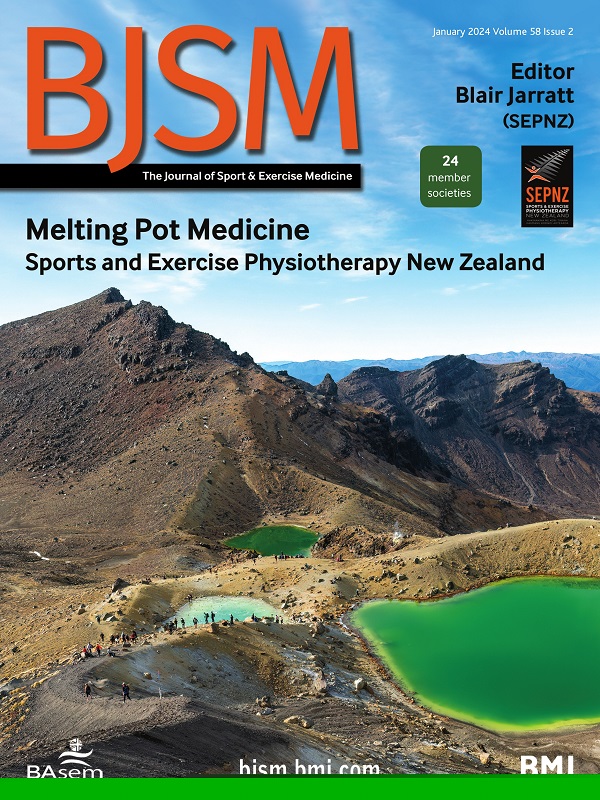Physical activity trajectories and accumulation over adulthood and their associations with all-cause and cause-specific mortality: a systematic review and meta-analysis
IF 16.2
1区 医学
Q1 SPORT SCIENCES
引用次数: 0
Abstract
Objective To understand the associations of trajectories and accumulation of physical activity (PA) over adulthood with all-cause, cardiovascular disease (CVD), and cancer mortality. Design Systematic review and meta-analyses. Data sources PubMed, Embase, Scopus, Cochrane Library, Web of Science, CINAHL, MEDLINE, SPORTDiscus, and reference lists of included studies. Eligibility criteria Population-based prospective studies with (1) non-clinical adult population, (2) PA assessed ≥2 timepoints as exposure, (3) all-cause, CVD or cancer mortality as outcomes with risk measures, and (4) publication up to 9 April 2024 and in English. Results 85 studies with three main types of PA exposure (ie, trajectory, time-varying, and cumulative/average) were included. Of these, 77 assessed all-cause mortality, 34 assessed CVD mortality, and 15 assessed cancer mortality. Overall, higher PA was associated with lower risks of all outcomes. Consistently and increasingly active individuals had around 20–40% lower risk of all-cause mortality and 30-40% lower risk of CVD mortality; however, the associations with decreasing PA patterns were less evident. Time-varying and cumulative/average PA illustrated similar inverse associations between higher PA levels and all-cause and CVD mortality. The associations were weaker and less robust for cancer mortality. Non-linear dose-response associations suggested risk reductions in all-cause and CVD mortality for meeting PA guidelines, but consistent/increasing PA below the guidelines also provided health benefits. Conclusions Consistently/increasingly accumulated PA over adulthood can reduce the risk of all-cause and CVD mortality, while the health benefits from decreasing PA patterns require further exploration. Data are available upon reasonable request. Data and codes are available from authors upon reasonable request.成年期身体活动轨迹和积累及其与全因和特定原因死亡率的关系:系统回顾和荟萃分析
目的了解成年期体力活动(PA)轨迹和积累与全因、心血管疾病(CVD)和癌症死亡率的关系。设计系统回顾和荟萃分析。数据来源PubMed, Embase, Scopus, Cochrane Library, Web of Science, CINAHL, MEDLINE, SPORTDiscus,以及纳入研究的参考文献列表。基于人群的前瞻性研究:(1)非临床成年人群,(2)PA评估≥2个时间点作为暴露,(3)全因、心血管疾病或癌症死亡率作为风险测量的结局,(4)发表时间截止到2024年4月9日,并且是英文的。结果共纳入85项研究,涉及三种主要的PA暴露类型(即轨迹暴露、时变暴露和累积/平均暴露)。其中77项评估全因死亡率,34项评估心血管疾病死亡率,15项评估癌症死亡率。总体而言,高PA与所有结果的低风险相关。持续和日益活跃的个体的全因死亡率降低了20-40%,心血管疾病死亡率降低了30-40%;然而,与PA模式减少的关联不太明显。随时间变化的累积/平均PA水平与全因死亡率和心血管疾病死亡率之间存在类似的负相关关系。与癌症死亡率的相关性较弱,也不那么强。非线性剂量-反应关联表明,符合PA指南的全因和心血管疾病死亡率风险降低,但低于指南的持续/增加PA也提供了健康益处。结论:成年期持续/不断累积的PA可降低全因和CVD死亡风险,而减少PA模式的健康益处有待进一步探索。如有合理要求,可提供资料。如有合理要求,可向作者索取数据和代码。
本文章由计算机程序翻译,如有差异,请以英文原文为准。
求助全文
约1分钟内获得全文
求助全文
来源期刊
CiteScore
27.10
自引率
4.90%
发文量
217
审稿时长
3-8 weeks
期刊介绍:
The British Journal of Sports Medicine (BJSM) is a dynamic platform that presents groundbreaking research, thought-provoking reviews, and meaningful discussions on sport and exercise medicine. Our focus encompasses various clinically-relevant aspects such as physiotherapy, physical therapy, and rehabilitation. With an aim to foster innovation, education, and knowledge translation, we strive to bridge the gap between research and practical implementation in the field. Our multi-media approach, including web, print, video, and audio resources, along with our active presence on social media, connects a global community of healthcare professionals dedicated to treating active individuals.

 求助内容:
求助内容: 应助结果提醒方式:
应助结果提醒方式:


